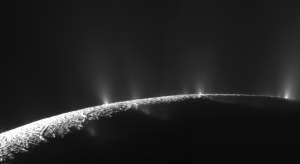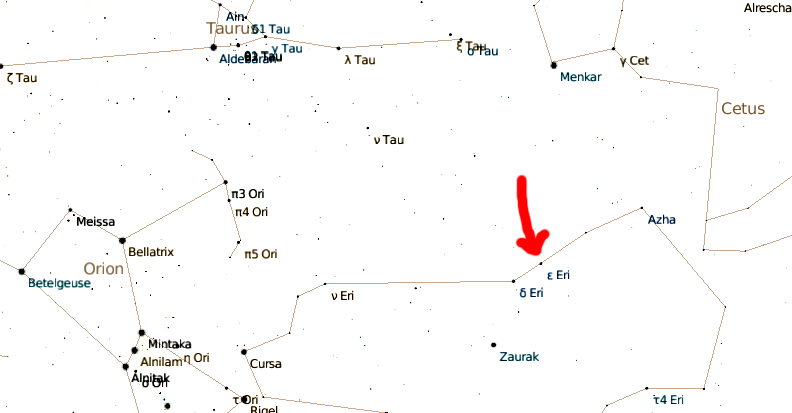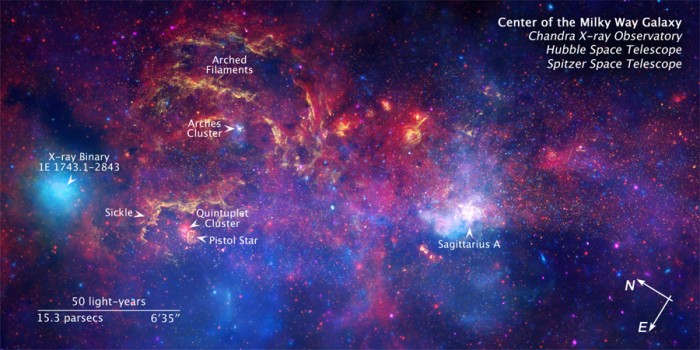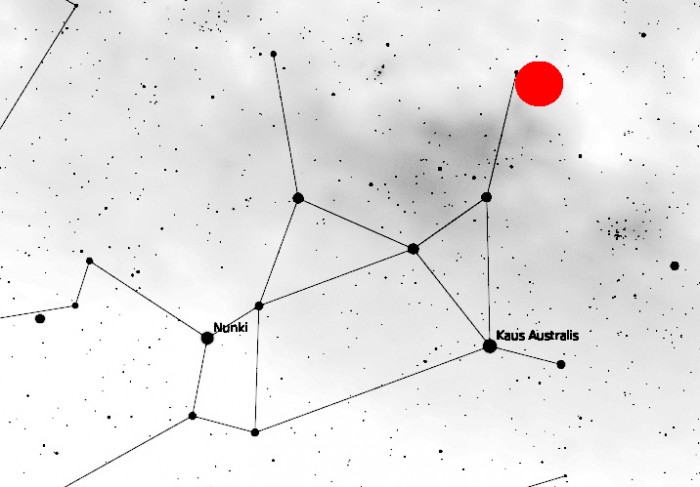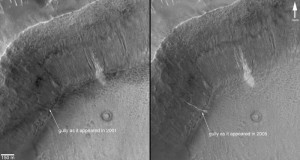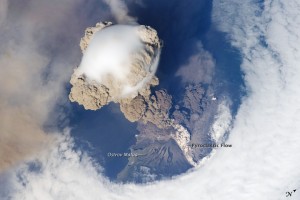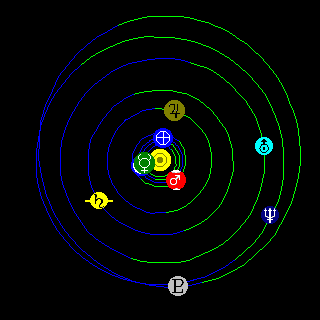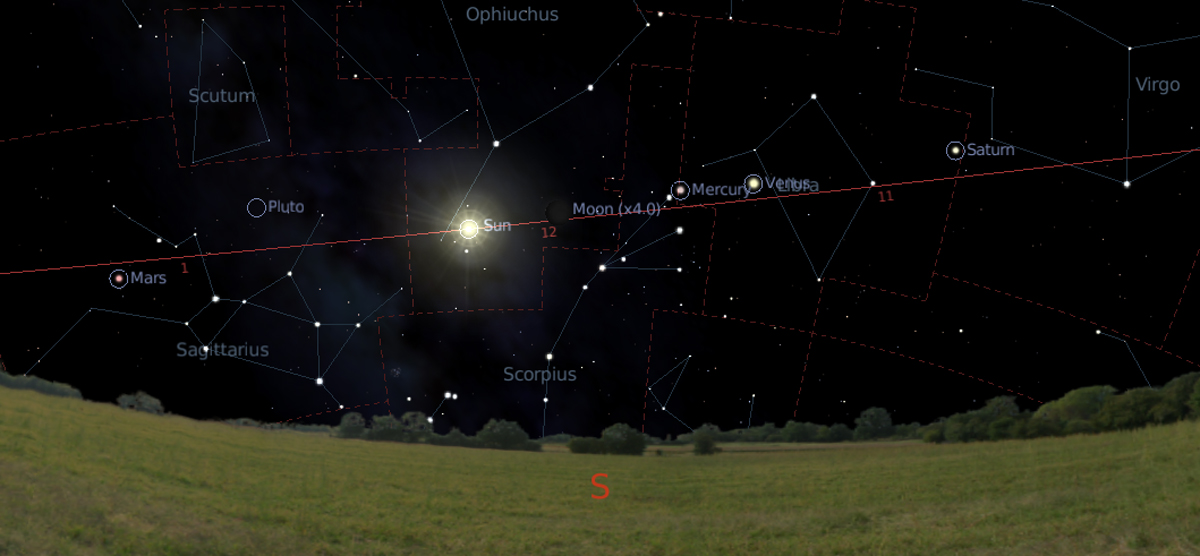Archive for November, 2009
 Thanksgiving and Astronomy
Thanksgiving and Astronomy
Thanksgiving is upon us, here in the United States. By now your in-laws, friends, acquaintances, and family have probably learned that you think Astronomy is cool. Which means you’re the expert. Awesome!
Wait, did that worry you a bit? Being called an expert in astronomy? I sure get worried when I’m called an expert. So, just for you, an astronomy cheat sheet for Thanksgiving dinner-table conversation! So, if you want to steer the conversation away from politics and religion, here are a few ideas – in no particular order.
Topics You May Be Asked About
Water on the Moon
Question: So I hear they discovered water on the Moon! Or, what was that a couple weeks ago about NASA crashing something into the Moon?
Answer: Yup! There have actually been a couple of discoveries recently, but when NASA’s LCROSS mission slammed into a crater at the Moon’s south pole, it kicked up a cloud of material (which is what they were hoping for), and they discovered water and a lot of other interesting molecules in that cloud. Is it enough to use? Yeah, but we’d have to clean out those other chemicals first which might be difficult.
More info about Water on the Moon.
2012
Question: I hear the world is going to end in 2012, what’s up with that?
Answer: No. The 2012 hoax is based on a bunch of misinformation and misinterpretations. The planets won’t be aligned, the poles won’t flip, and neutrinos from the Sun won’t boil the Earth’s interior. Intriguingly, we will have a solar maximum in 2013, so 2012 promises to have some nice sunspots, flares, prominences, and other Sun activity.
More info about 2012.
Mars
Question: These questions have a wide range: from “Is there life on Mars?” to “How are those Mars missions doing anyway?”
Answer: Yes, we’ve found water on Mars, though not a lot. We’ve found that water many times. The most recent surface expeditions to Mars were Phoenix (at one of the poles, currently probably under a layer of ice), Spirit and Opportunity (which both had rovers). Phoenix is now defunct, as there is no sunlight from which it can draw power. Even when the Martian winter recedes and the Sun shows up again in spring don’t expect Phoenix to turn back on. Spirit and Opportunity have been going for almost 6 years now – and their original mission was slated for 90 “sols” (days on Mars). Their 6-year anniversary is January of 2010. At this moment Spirit is stuck in a sand trap, and the NASA JPL techs are working hard to extricate her.
And no, we haven’t found life there yet and the chances are getting slimmer.
More info about water on Mars, life on Mars, Phoenix, and the rovers.
Hey, What’s That?
Question: Hey, what’s that?
Answer: Jupiter.
Well, it is possible that it is Sirius or Mars, but you’d have to be up fairly late with your family for that to be the answer. If you’re out for a post-dinner walk, and you notice something bright in the sky, it is probably Jupiter. To double-check yourself, Jupiter is low in the southwestern sky before sunset here in the United States.
More info on what’s in tonight’s sky.
CERN
Question: I hear they turned on that world-destroying black hole maker again.
Answer: Yup! I mean, no … it isn’t a world-destroying black hole maker, but they (CERN) did turn on the “LHC” (Large Hadron Supercollider) in Switzerland. They’ve turned it on, spun it up, and even gotten collisions of particles! Yay! Now, it will still be a bit until they discover that strange particle they’re looking for. And maybe a little longer until they prove that dark matter is real.
By the way, did you know that CERN stands for European Organization for Nuclear Research? How does that make sense? (Well, okay, I get the “RN” instead of “NR” part, but … I don’t get the “CE” instead of “EO”)
More info on CERN.
Topics You Might Like to Bring Up
Free Spirit
Pitch: We have a remote-control car stuck in a sand trap on Mars.
Details: Well, it’s actually a lot cooler, more difficult, and more emotionally wrought for many folks than just a remote control car and a sand trap. Spirit, one of our two rovers on Mars has gotten hung up in some soft soil. It has been trapped for weeks – the soil is softer than they expected, and there may be some loose rocks hidden by the sand which make plotting a course almost impossible. Every movement is like sinking into quicksand – it causes the rover to slip deeper into the soil. Also, there are some indents on the bottom of the rover that could easily get hung up on some sharp rocks underneath Spirit’s belly if the rover sinks too far. The rescue operation is continuing.
More information on Free Spirit.
Galileoscope
Pitch: The only decent cheap telescope on the market.
Details: For the International Year of Astronomy a working group was put together to design a cheap, decent telescope kit, that any kid could use to see the rings of Saturn. This telescope is amazing for the price – and you get to learn how the optics work while putting it together. It also only takes about 10 minutes to assemble and no tools are required. This is a good beginner scope, but you should complement it with a tripod to get any use out of it at all. I highly recommend the give-one-get-one option, because they’ll send Galileoscopes to kids in underserved countries with these donations.
More information on the Galileoscope.
Shuttle Missions
Okay, watch out because this one could turn into a political conversation.
Pitch: There are only 5 shuttle missions left until the Space Shuttles are all retired.
Details: It’s about time we created a new ground-to-orbit technology. The Shuttles were launched in the 80’s (raise your hand if you’re still driving a car that was built in the 80’s. I thought so – not that many of you). Besides, if your clunker breaks down you’re stuck on the highway and you call AAA for a tow. If your shuttle breaks down … well, we’ve seen that twice and it is heartbreaking. I remember both vividly, and I’m actually just barely old enough to be able to remember the first one.
More info on the shuttle retirement, and the replacement.
Enceladus
Pitch: Yowsers watch out for those geysers!
Details: Cassini, which has been in orbit of Saturn for some years now, has just done a couple of screamingly-close flybys of Saturn’s moon Enceladus. Why do you care? Because Enceladus is on the short list of places in our solar system we rate as likely for finding life. In fact, one scientist has ranked it as “more habitable” than Earth, based on a set of seemingly-reasonable characteristics. You also care because, well, why are there geysers on this moon? What are they made of? What do they mean? We don’t know all those answers yet, but Cassini will help us figure it out.
More images from Enceladus.
My favorite (click and look closely at the dark side …):
I wish you a wonderful Thanksgiving, if you celebrate it, and a wonderful Thursday, Friday, and weekend if you don’t.
![]()
~ A l i c e !
 November-December 2009
November-December 2009
Yup, this is late. Way late. Enjoy!
2009 November-December Starmap
(Also, a Carnival of Space (#130) over at Chandra!)
Notable Sky Objects
HEY ALICE! I SAW …
Well, the answer this month is probably clouds, if you live in the same general area as I do. The Pacific Northwest has been pretty well socked in. My other best guess this time of year is Jupiter, bright in the Southwest just about to set.
(If you’re wondering about the heading for this section read this).
JUPITER
Jupiter will be highly visible in the early evening in the Southwest, setting a few hours after sunset. If you pull out some binoculars and steady yourself against something, you should be able to pick out the moons of Jupiter, just like Galileo did 400 years ago.
MARS and SATURN
Mars is rising about 10pm or a little earlier in between Leo and Cancer, and Saturn rises around midnight in Virgo.
VENUS and MERCURY
Venus and Mercury are not visible, they rise and set with the Sun.
EVENTS
November 17 – The Leonids meteor shower. It happened already, and wasn’t too spectacular, but the predictions I was reading were saying that there was a small chance of a short outburst.
November 18 – Unveiling of new NASA Images at Pacific Science Center. If you missed the unveiling, don’t worry, you can still come and oogle the images – they’re on the wall by the Willard Smith Planetarium.
Last half of November – Space Shuttle Atlantis has an 11-day mission to the International Space Station. Only five more shuttle missions left. :( Keep your eyes peeled for Marian Call’s new song “Good Morning Moon” about waking up onboard the ISS. I heard it last night and it is awesome.
November 26 – Pacific Science Center closed.
November 27 – Planetarium shows at Pacific Science Center are on a weekend schedule.
On Mars – Spirit is moving! Keep an eye on it, the drivers are being very careful because they can’t call AAA from Mars, it’s too far to send a tow truck.
December 9 – WISE is aiming to launch. This new telescope will be watching the sky in infrared.
Last half of December – Don’t miss The Star of Bethlehem planetarium show. You can get tickets at our ticketbooths or online (this show might not be quite programmed into the ticketing and scheduling computers yet, so if it isn’t check back next week or e-mail me after December 1: alice_enevoldsen (a) pacsci.org).
New Constellations
ORION – The Hunter
SCIENCE: Don’t miss M42 – The Orion Nebula. When looking at the constellation, it’s where Orion’s sword is hanging from his belt. It’s a star-forming nebula made of gas and dust.
MYTH:The Bororo Indians of Brazil see a fearsome caiman in the stars of Orion. The Black Caiman of the Amazon is one of the largest types of alligators, and one of the few that poses a danger to humans. Sadly for the Black Caiman, we pose more of a danger to it: it has become an endangered species due to human hunting of its skin.
TAURUS – The Bull
SCIENCE: We’ve got two open clusters in Taurus – The Pleiades (in his shoulder) and the Hyades (the “V” shaped head of the bull. Open clusters are a small collection of stars that are actually gravitationally bound to each other. They tend to be young, newly-formed stars that are slowly moving apart from each other.
I love to mention that the Pleiades are my favorite deep sky object in the night sky – because they look different every night. Depending on the weather and your eyes, you might see a smudge, 4 stars, 6 stars, or even 10. With binoculars you’ll see dozens of stars. With a telescope you’ll see hundreds. It’s a great gateway into astronomy.
MYTH: Taurus is Zeus – in the bull form he used to conquer Europa. A slightly more family-friendly version of the story has Orion fighting Taurus the bull – and the Pleiades are a wound where Orion has stabbed him.
GEMINI – The Twins
SCIENCE: Castor and Pollux are the “head” stars of the twins. Castor is a septuplet star – three pairs of stars orbiting a common center of gravity. Yii! Six!
MYTH: India also considers these stars twins, they are called Aswins, the twin horseman associated with the dawn.
PISCES – The Fish
SCIENCE: I find Pisces by starting with the circle at the top. It doubles as Pegasus’s wings, although it is officially part of Pisces.
MYTH: The only way I can make heads or tails of this constellation is to see it as two fish on an upside-down fishing line.
CETUS – The Sea Monster
SCIENCE: As it is far out of the plane of the Milky Way, it is easier to see other galaxies in this area of the sky with a good telescope, though none of them are naked-eye visible.
MYTH: Cetus is part of the giant Andromeda/Cassie/Perseus/Cepheus/Pegasus mythology.
AQUARIUS – The Water Bearer
SCIENCE: There are a few clusters and nebulae in Aquarius, but the one that I find most beautiful is the Helix nebula. It’s a planetary nebula – an exploded envelope of gas around a dying Sun-like star many, many years ago. Do not confuse it with the Ring Nebula – it looks similar, and is the same type of nebula.
MYTH: Aquarius is the Water-bearer. This is also the constellation referred to in the phrase “Age of Aquarius” – but that’s of astrological significance, which I can’t speak to.
“Tiny” Guys
Going for the Gold? Here’s this month’s itty-bittys.
SCUTUM – The Shield
CAMELOPARDALIS– The Giraffe
SCULPTOR – A Sculptor’s Studio
ERIDANUS – The River
SCIENCE: Epsilon Eridani (ε Eri, a star in Eridanus) is a Sun-like star, AND we’ve detected two debris belts (like our Asteroid Belt and Kuiper Belt) around it. Beyond that there are at least two planets there.
TRIVIA: ε Eri is a very popular location in science fiction. In this case, I recommend the Wikipedia article. Notably – Babylon 5 is located at ε Eri. I thought I had been told that Vulcan orbited ε Eri, but I can’t find official confirmation of that. Vulcan is supposedly 16 lightyears away – ε Eri is 10 lightyears away.
TRIANGULUM – The Triangle
ARIES – The Ram
LYNX – The Lynx
LACERTA – The Lizard
EQUULEUS – The Little Horse
SAGITTA – The Arrow
VULPECULA – The Fox
Returning Constellations
ANDROMEDA – Princess Andromeda
PEGASUS – The Winged Horse
CEPHEUS – King Cepheus
PERSEUS – Perseus
DELPHINUS – The Dolphin
AQUILA – The Eagle
CYGNUS – The Swan or the Northern Cross
LYRA – The Harp
URSA MAJOR – The Great Bear
URSA MINOR – The Little Bear
CASSIOPEIA – The Queen
Where’d I get my Info?
My memory, and Zeta Strickland
For a good beginner’s guide to the sky, try StarDate, Sky and Telescope’s Stargazing Basics, or Sky and Telescope’s links to lots of beginning topics.
Happy sky viewing, and if you can’t get your fix because of clouds, play with some of the online telescopes.
![]()
~ A l i c e !
 More Happenings!
More Happenings!
Life just keeps on coming! Here are a couple more spacey things happening tonight and this week.
Hubble Unveiling
The unveiling of our new Hubble/Chandra/Spitzer images went off without a hitch this morning, and Q13 interviewed us. If you want a peek at the pictures or need to know just why they are so cool, watch for me on Seattle’s channel 10 at 9pm or channel 13 at 10pm tonight.
Next up…
A lecture – free with admission to Pacific Science Center
Saturday, November 21, 2009 at 1:30PM in Rooms 411 and 412 (in Building 4)
The Lives of Stars
By Dr. Ken Croswell
The stars that speckle the sky have long fascinated humanity, but only in the past century have astronomers figured out how stars are born, live and die. Now we can use that knowledge to address the question: Which stars near the Sun might have planets with intelligent life? Drawing on both the laws of stellar evolution and the latest discoveries of extrasolar planets, Harvard-trained astronomer Dr. Ken Croswell describes the lives of stars and the alien worlds they may support.
The presentation will be family friendly and Dr. Croswell will sign his new book, The Lives of Stars after the presentation.
![]()
~ A l i c e !
 Huge New NASA Photos at Pacific Science Center
Huge New NASA Photos at Pacific Science Center
Pacific Science Center just installed some amazing new photographs. They’re right outside the planetarium, beside the Gemini Capsule. Our public unveiling of these images is today, November 18th at 10am.
The images we’re putting up are a celebration of the International Year of Astronomy from three of NASA’s Great Observatories. I’m going to show you the images here, but to appreciate their full majesty you’ve got to stop by and see them in person.
I’m also putting up the key to the images, so you can use them to do a treasure hunt when you come to visit.
Some Quickie Tech Details
- Distance to these formations: 26,000 light years
- Width: 246 light years from edge to edge (really 32.5 arcminutes if you want to get technical)
- Color: This is a false-color image. Reds are infrared from Spitzer, yellows are near-infrared from Hubble, and blues are X-ray from Chandra. To see it look this beautiful you’d have to be some kind of alien with fancy eyes that see in a very wide range of wavelengths. None of the wavelengths represented here are visible to the human eye.
Where Is It?
Where’d I Get My Info?
And Some Carnivals of Space!
#129 from Tiny Mantras – featuring my 2012 movie review post and some really interesting stuff about Unicorns …
#128 from AARTScope – featuring a quiz on IYA and “How to talk to your friends about 2012” from me
#127 from Next Big Future – seems to be all about the awesome Ares 1-X Launch
#126 from The Gish Bar Times – has my video about telescope purchasing, and a lot about the Moon
#125 from Orbiting Frog – is very easy to read, check it out!
![]()
~ A l i c e !
 Image Unveiling Celebration at Pacific Science Center
Image Unveiling Celebration at Pacific Science Center
Pacific Science Center just installed some amazing new ginormous photographs. They’re right outside the planetarium, beside the Gemini Capsule. Our public unveiling of these images will be Wednesday, November 18th at 10am.
The images we’re putting up are a celebration of the International Year of Astronomy from three of NASA’s Great Observatories, and we’re launching a full morning of fun celebrating everything space-y! There will be fun space exhibits from Science on Wheels, science experts on hand, and free planetarium shows … not to mention the pictures themselves.
I have a number of free passes good for that morning: e-mail me at alice_enevoldsen (at) pacsci.org if you’d like some for you and your friends. See you there!
A tantalizing hint:
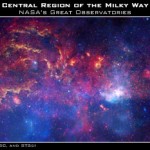
The Center of our Galaxy
![]()
~ A l i c e !
 The Moon Has Water
The Moon Has Water
“The Moon Has Water!” News Releases
This table has been created to be updated. The latest update is the date of the latest news release. This post is based on my Mars Has Water post that I’ve been updating since 2006. No matter how exciting it is to find water in these places, the press releases often have the same title: “[Planetary Body] Has Water!” Well, yes, and often we’ve found water there before. Each individual discovery has something new and interesting though, so I’m collating a list of those discoveries here. If you know of a discovery I’m missing, please e-mail me.
| Date News Released | News Title, Mission, Evidence (and what’s special this time) |
Reliability of Evidence | Amount of Water | Date the Water May Have Been Liquid |
| November 13, 2009 | LCROSS Impact Data Indicates Water on Moon, spectrometers on board the LCROSS Mission, two plumes of material ejected when LCROSS hit the Moon both show evidence of water being kicked up, this time we kicked the water up ourselves showing the concentration of water below the surface of the crater Cabeus | High | Small, but enough to melt and use (“The plume from the impact contained at least 100 kilograms of water”) | A long time ago if ever. |
| September 24, 2009 | NASA Instruments Reveal Water Molecules on Lunar Surface, M3 on Chandrayaan-1, VIMS on Cassini, High-Resolution Infrared Imaging Spectrometer on Epoxi (Deep Impact), spectra data at the polar regions show hydroxyl and water molecules distributed through the surface of the Moon | Medium | Very Little – 10 to 1000 parts per million (at most one liter of water in one ton of lunar rock) | Possibly never, we’re talking individual molecules of water and hydroxl, probably adsorbed (stuck) to the surfaces of various minerals. |
| March 5, 1998 | Lunar Prospector Finds Evidence of Ice at Moon’s Poles, neutron spectrometer instrument on board Lunar Prospector, spectra data suggesting concentrations of water at Moon’s Poles | Low | Very little – 10-300 million metric tons (the low number is around the size of Lake Union) | No estimate. |
| December 21, 1996 | Ice on the Bone Dry Moon and Ice on the Moon, Bistatic Radar Experiment on Clementine, radio waves bounced off of permanently dark craters suggests ice deposits | Low | Very Little – 100 million to 1 billion metric tons (The small number is four times the size of Lake Union, or a third the size of Lake Sammamish) | No estimate. |
![]()
~ A l i c e !
 Answering Questions: Life on Mars?
Answering Questions: Life on Mars?
Kiri writes –
Ok, then–thanks very much! Now… *clears throat*1. Do you know of any unfrozen water on Mars?
2. Is there any evidence of life on Mars’s moons?
3. What is/are Phobos and Deimos’s general profiles? (i.e.
Atmosphere, temperature, ect.)
4. What might Martians be like?
6. What are some famous theories on Martian life?Thank you very much for your time!
Kiri, good questions. I will take them in order.
Unfrozen Water on Mars
First I will refer you to a blog post I try to update every time there is a discovery of water on Mars. Pretty much all of these discoveries are of ice – though some are of ice that sublimes (evaporates) into a gas.
You know how when you have an ice cube, if you let it sit out it melts into a puddle of water, and if you let that puddle of water sit out eventually it evaporates and you’re left with nothing? Well, on Mars you get to skip the “puddle of water” part, and ice evaporates directly, without melting first. This is called subliming. Intriguingly this happens in Seattle fairly often too: when we get enough snow to cover the ground the air is usually also pretty dry. We usually do not have rain for a few days. You can watch how the snow disappears, but the ground around the snow stays dry.
Here is a picture of what it looks like:
Notice how the ground around the snow is not wet, but you can tell that there is now less snow than there was when the snow must have fallen? On Mars this is what almost always happens, because it is so cold on Mars.
Now, here’s the other piece.
This is evidence of liquid water. As you know from seeing rivers, streams, and from looking at the Grand Canyon, water can shape the land. It can cut valleys, pick up loose dirt, and even reshape rocks. In the pictures linked to in this press release you can see a new gully.
There are other ways this gully could have formed, but it does look quite a lot like a gully formed by flowing water. Although NASA didn’t catch a picture of the water itself, this suggests that there was liquid water flowing on Mars between 1999 and 2005.
Life on Mars’s Moons
Nope. Mars’s moons are tiny rocks in space, there is no indication that they have the things we think are necessary to support life: liquid water, a temperature at which water can be liquid, and preferably an atmosphere of some type.
Phobos and Deimos’s General Profiles
I love picking up information like this from Bill Arnett’s Nine Planets and the NASA site also has some good information.
Phobos has an average diameter of 22.2 km – that’s like the distance from the Pacific Science Center to SeaTac Airport. For comparison, our Moon has a diameter of 3476 km or the distance from Pacific Science Center to Chicago. Deimos is a little more than half the size of Phobos: 12.6 km or a little less than the distance from Pacific Science Center to the Museum of Flight.
It is probably useful to think of Phobos and Deimos as small asteroids rather than as moons – they do in fact orbit Mars, but they’re just tiny rocks. They are thought to be partially ice inside, and Phobos has a thin layer of dust like our Moon. Surface dust on other bodies besides the Earth is called “regolith,” the word “dirt” is reserved for our planet, and for surface material that has some organic material. The dirt we’ve got here is partially ground up rock, but also partially decomposed plant and animal matter: organic material.
Both Phobos and Deimos are too small to have atmospheres. In order to have an atmosphere you have to be able to “hold on” to that atmosphere – you have to have enough gravity to keep the atmospheric gasses from drifting off into space. Phobos and Deimos do not have enough gravity to do that. Even Mars loses a lot of its atmosphere to space because it is so small, and it is a lot bigger than its moons.
The temperature on both moons varies a lot. With no atmosphere to mellow out the temperature the daytime side is cold (Phobos was measured at 25F) and the night side is really freezingly cold (-170F on Phobos). I do not plan to visit anytime soon.
Martians
Seeing as how we haven’t found any yet, if we do find Martians I’d expect them to be microscopic life forms – bacteria, algaes, or maybe lichens. Anything would have to adapt to using ice instead of liquid water, and be able to be frozen for months at a time.
But, if we toss aside the fact that we haven’t found anything yet and start to think of larger lifeforms we can combine what we know scientifically with our imaginations to come up with what we might have found. Consider:
- Mars has lower gravity than Earth
- Mars has a thinner atmosphere than Earth
- Mars’s atmosphere has more carbon dioxide and less oxygen
- Mars is much colder
- Mars has very little liquid water, so life would have to use ice instead
My dreamed-up Martian would be very tall (because of the lower gravity), have huge lungs (to get enough oxygen), be covered in a thick layer of fat and fur like a polar bear (because of the cold), and would have very warm stomach, so that as it ate ice the ice would melt and turn into liquid water inside.
How would your dreamed-up Martian adapt to these conditions?
Famous Theories on Martian Life
The most famous are all in science fiction – but there was one scientific discovery that caught the limelight for while. It was later determined to be incorrect, but it was exciting anyway.
The meteorite that started it all was called ALH84001 – and a team of scientists announced that they had found evidence suggesting fossilized microscopic organisms inside this meteorite from Mars.
Here is a recent article about Life on Mars, and here is one of the original websites about this meteorite. Bear in mind as you read this one that it is completely out of date, and the shapes that were thought to be fossilized microscopic organisms were determined not to be.
I hope that is helpful!
![]()
~ A l i c e !
 2012 – The (2009) Movie
2012 – The (2009) Movie
Um. Um. Um. Um. Where do I begin?
The movie was entirely preposterous. There almost wasn’t enough science to make fun of! It ranks way above Sunshine in my ranking of action flicks full of terrible science, and yet it barely holds a candle to Armageddon. Perhaps no one can top Armageddon as the best movie to show an intro Astronomy class: the best movie to ask Astronomy students to rip to shreds.
I think we (the astronomy educators of the world) were worried about nothing. If this movie convinces anyone that the 2012 hoax is real, then they weren’t watching the movie.
In any case, here goes!
======SPOILER ALERT 4======
.
.
.
.
.
.
======SPOILER ALERT 3======
.
.
.
.
.
.
======SPOILER ALERT 2======
.
.
.
.
.
.
======SPOILER ALERT 1======
NO REALLY! STOP READING NOW!
Science: F (A=perfect, F=utter failure)
Blood & Guts: 1-2 (0=none, 5=District 9 & Zombie movies)
Illness & Medical Awfulness: 0 (0=none, 5=Outbreak & District 9)
Scariness: 2, mostly just suspense (0=none, 5=I’ve never seen a “5” but Outbreak gave me nightmares for years – so maybe 5 is Jaws or Psycho)
Other Phobias*: “apocalysophobia”, suggestion of vertigo, aviophobia, hydrophobia, necrophobia (fear of losing spouses or children and fear of death), amaxophobia, fear of conspiracy, and fear of flying giraffes.
Opening Scene:
I can’t even tell what planets those are supposed to be they’re so wrong. At first I thought it was Nibiru on a collision course with Earth and the Moon, but since there is no further mention of Nibiru I doubt that’s right. And then there’s Saturn with a stripy-like-a-gas-giant moon. Uh-huh. No, Saturn’s moons don’t have gas bands like Jupiter.
And the scale is ALL WRONG on the clip of the Earth and the Moon and the giant coronal mass ejection coming off the Sun. Of course, you couldn’t fit all three in a dramatic image even if you wanted (the Sun would wash out the whole image, and to get the sizes anything like that you’d have to be on the other side of the Moon, not the other side of the Sun) to so maybe we can pretend it is a split-screen shot. Mm-hmm.
Solar Eruption:
YES! Okay, they got one thing right. They do not call the giant bubble of Sun-stuff headed towards Earth a solar flare as would be tempting. They call it a solar eruption. Technically I’d call it a coronal mass ejection (CME), but solar eruption is at least not reinforcing a common misuse of a scientific term.
Neutrinos:
This is the crux of the whole movie. It’s also the science-y-est the movie tries to get. (And then later they kill off the astrophysicist who gives this explanation – just as well, this science was, what’s that word again? Oh yes, preposterous!)
Neutrino detector – great, it is deep underground, and it’s got those detectors on the wall to make it look like Super-Kamiokande, but the people climb down inside and the detectors aren’t even in a place where they can detect Cherenkov radiation within the water. The water is through a hatch! And the mine is in India – 11,000 ft deep. Super-K is only 3,250 feet deep. It looks to me like our deepest mines are actually around that deep – but they’re in Africa not India.
Some quick look-ups online reveal at least one 2008 paper from Super-Kamiokande (published in the peer-reviewed Physical Review) that shows no correlation between sunspot number (a measure of solar activity) and neutrino levels. It also does not find a doubling of the number of neutrinos detected during Solar Maximum. Of course, this being the cause of the apocalypse in the movie, maybe we should just let them have doubled neutrinos.
Except that wouldn’t cause the apocalypse – as they say in the movie neutrinos do not interact with ordinary matter! This is why we have to have super-specialized detectors deep underground to even detect a few of them. So they have to turn the neutrinos into microwaves. Well, what can I say to that? If you’re just going to turn gnats into electricity or elephants into ocean waves I guess you can do anything.
Then those microwaves begin to boil the Earth’s core. Oh.
Mass Suicide:
This is what I actually worry about. If too many people believe the 2012 hoax, then there will no doubt be a number who take drastic action. Please don’t. You will wake up just fine on December 22, 2012, unless you do something to change that. Suicide is not a good option, neither is anything that hurts you or those around you. If you feel like hurting yourself is a good idea please go talk to your doctor or call your local helpline.
Maya Prophecy:
The “Maya Prophecy” says nothing about the Sun. The calendar flips over. Ta-da!
Geology:
It confuses me how the cracks run down the middles of streets – turning corners with the street. They worm out of the geology by saying the earthquakes and cracks aren’t due to tectonic shift. It also confuses me that these cracks propagate slowly (at about a walking pace), and that they cut buildings like cake: leaving most of the structure intact.
Soil Liquifaction:
This is a real geology term. It generally requires that the ground be saturated with water and then that an earthquake occurs. It does not mean that the soil turns to water, that rocks melt, or anything like that.
Yellowstone:
Yellowstone is the caldera of a hot spot (not “hot zone”) in our Earth’s crust, and could do some interesting things someday. I’d sure stay away from all volcanic areas (yes, that includes Yellowstone) if the Earth’s core/mantle were heating up. Under the circumstances of the movie, Yellowstone would definitely be unstable.
I like some of the beginning stuff that goes wrong in Yellowstone – the lake drying up (though the dead buffalo is really weird and reminiscent of Close Encounters of the 3rd Kind. I don’ t know why it is dead, it certainly isn’t because of the neutrinos.)
Then there’s something about 2700 degrees C and 0.5% change per hour. Math senses tingling – but I didn’t quite catch everything in this sentence so I can’t actually double-check this.
Later on, the way Yellowstone rolls and explodes into flaming balls of lava is cinematography, but how else would you have John Cusack outrunning boulder-sized “meteors” of flaming rock and a rolling ashcloud first in an RV and then on foot? I mean come on! A movie like this needs a man outrunning flaming balls of rock.
Pickles:
Why?
Charlie Frost’s Explanation of the Apocalypse:
No. And you should be able to tell that from his character and his animations.
Mayan expiration date: yeah, but just flip your calendar and you’re okay again.
Alignment of all the planets with the Sun and the galactic center: No. No. No. There is no alignment of the planets in 2012. The alignment of the Sun with the galactic center either happens every year near the solstice or will happen in 2300 depending on how exact you want to be. Does this happen every 640,000 years? It takes us 220 million years to go around the galaxy once, and we go through the plane an unknown number of times during that period.
Neutrinos: we already talked about this.
Earth’s core melts: a good part of it already is melted!
Earth crust displacement theory: There was a guy who proposed Earth Crust Displacement – a massive simultaneous rotation of the Earth’s crust, and Einstein did write a forward to one of his books. It is very important to note that this was in the 1950s – and the currently accepted theory of plate tectonics was not solidified and accepted until the 1960s. My geology professors were not taught plate tectonics when they were in intro geology classes, and now even elementary schoolers can explain it. Einstein was very smart, but he did get things wrong, and scientific theories change as we get more evidence that supports or disproves them. When scientists don’t understand something they propose many possible solutions and then gather data – this helps them choose the theory that is best supported by the evidence.
10.9 on the Richter Scale
Personally, I like the Mercalli scale much better when reporting how “bad” and Earthquake was. It isn’t as useful for a scientific study, but in this case San Francisco would have undergone a “12 – Catastrophic – No structures left standing, landscape distorted” which is easy to understand: total chaos. But 10.9 on a logarithmic scale? What does that even mean? (Let me clarify: I have no gut understanding of 10.9 – but it does have scientific meaning.)
“The San Andreas Fault is shifting …” (says Adrian)
Why would the San Andreas Fault (and all connected faults) be shifting if the earthquakes aren’t due to tectonic shift? Script continuity please!
San Francisco slides into the Ocean
If we’re really having non-tectonic Earth crust displacement due to melting of the subterranean crust and core – and a piece of a continent starts to submerge, shouldn’t it be submerging in the mantle? Why does it look like it is just plain sliding into the ocean? I’m not sure the ocean just off San Francisco is deep enough to slide an entire city into. We’re still on the continental shelf at that point, and you’ve turned the city on end to sink it.
Yellowstone Eruption:
I already said it’s preposterous, so let’s look at just a couple pieces. First, it looks like a nuclear bomb blast surrounded by three rings of clouds, probably meant to be shock waves.
Look at this (this is real, it’s from the International Space Station in June 2009):
That looks kinda similar – but scientists aren’t proposing that the smooth white cloud is a shock wave, just a cloud generated by changing pressures. Maybe that’s what the makers of 2012 were attempting to portray – a volcanic plume so huge it passes through three different layers of air creating three different concentric clouds.
And yes, you should get away from erupting volcanoes because of ash clouds, superheated ash/rock flows, and worst of all – lahars (superhot, superfast mud flows). Not sure where the lahars would go from Yellowstone, but the best advice in volcano country is to stay out of riverbeds and get to high ground – high ground away from the volcano. These various flows can travel up to at least 300 miles per hour – poor John Cusack he should be so dead.
That ash cloud from Yellowstone reaches DC in just about 7 hours. That sounds okay, it’ll be picked up by the prevailing winds and it only takes a plane 5 hours to cross the country. Of course, it will be somewhat dispersed by then and won’t look like the rolling superheated cloud of the apocalypse so much, but depending on how much of Yellowstone you blew up it could make a decent ash layer over most of the country. There really wouldn’t be that much heading towards the West Coast though, the winds will push it back the other way.
Cell Phones:
Seriously folks, you’re destroying the world, dumping entire cities into the sea, blowing up continents, and yet somehow, miraculously your cell towers are undamaged and you have signal everywhere? Cell phones are NOT satellite phones, they rely on cell towers. Cell towers are anchored to the ground.
Planes Taking Off, Runways Eroding
Almost every time we see a plane take off, the runway crumbles away beneath it, and the plane goes off the end into a chasm, because it hasn’t reached take-off velocity yet, only to see that plane plummet a few stories, gain control and pull up out of the brand new canyon. This is okay – planes are made to fly – that’s what a wing is for. Engines just give you speed. If you’re already airborne, and you’ve got a good pilot, you can glide the plane until you get your engines under control. And if you need more speed, what better way to get it than going down? Gravity-assisted take-off, I say!
Geomagnetic Reversal
So we end up with the South pole somewhere in Wisconsin. The mechanism is all off, the timeframe is unpredictable, but yeah, the magnetic poles reverse every now and then – every few hundred thousand to few million years. This should not be related to Earth Crust Displacement theory or 2012.
The Physics of Driving a Car out of the Cargo Bay of a Crashing Airplane
I would like to analyze this in more detail. Suffice it to say for now – I think the car should be moving in the same direction as the plane when the car’s wheels touch the snow. If anyone wants to crank out some math and force diagrams on this with me, that’d be great, I don’t have time at the moment.
Boarding the Ark
Two warnings. 1) You’ve got 20 minutes of Titanic to sit through here, but you’re almost done. 2) The drowning scene is not nearly as realistic as the one in the recent Bond flick: Casino Royale. You can probably handle it.
On Board
Now we have mountain-high tsunamis, and our cell phones STILL WORK.
There’s this fascinating thing that is about to happen – with the pretty “v”-shaped cleft that the arks are positioned at the end of, you’ve created what looks to me like a perfect tidal bore: a path for a wave to travel, gaining energy as it comes towards you until you’re hit with the brunt of the energy much harder than you would have been had you been at the mouth of the valley, rather than the back of it. This is what will happen to Olympia, WA if a tsunami ever is positioned just right to enter the Straight of Juan de Fuca and comes crashing down through Puget Sound. Olympia, albeit farther from the source, will be hit harder than Seattle.
Okay, when you designed your arks, and you designed the anchors to fail after the first crashing tsunami, why did you not also design them to withstand things like: crashing into each other, crashing into large debris (like airplanes) in the water, and crashing into rocks? Did you assume that after your anchors failed at that first wave the seas would be calm and you could float peacefully under a rainbow looking for a dove to return?
Africa
Africa gets uplifted, but at this point you can do whatever you want with the tectonic plates because you’ve set up a completely fictional idea anyway. So they set sail and ::phew:: we open the gates and breathe fresh air again.
Credits!
NO REALLY! STOP READING NOW! (Just in case you’re reading from the bottom up for some weird reason)
======SPOILER ALERT 1======
.
.
.
.
.
.
======SPOILER ALERT 2======
.
.
.
.
.
.
======SPOILER ALERT 3======
.
.
.
.
.
.
======SPOILER ALERT 4======
*If you see this movie and you think of other fears it may raise let me know and I’ll add them to the list.
![]()
~ A l i c e !
 Video: 2012 and Lecture: The Moon
Video: 2012 and Lecture: The Moon
Did you miss my little chat plus Q&A on 2012? Lucky you – KCTS recorded it and you can watch it here!
P.S. Don’t miss the lecture at the Pacific Science Center tomorrow (Thursday) night by Andrew Chaikin.
![]()
~ A l i c e !
 2012
2012
Update as of 11/2012: I am available to speak to your group on this topic in the greater Seattle area. E-mail me if you’re interested: alicesastroinfo [at] gmail [dot] com.
The 2012 Hoax – The Kitchen Sink
What do the non-existant planet Nibiru, the rollover of the Maya Long Count, a long-expected and non-conjunction of planets, some sunspots, and a lack of reversal in the Earth’s magnetic field, and the continued alignment of the Earth, Sun, and galactic center have in common? They all got picked up and sensationalized as part of a 2012 apocalypse story. This “hoax” rolls pretty much every apocalypse story into one.
Actions – (or “how to talk to your friends about 2012”)
- Validate – Your friends are intelligent people: treat them as such. Validate their interest in the topic and any correct facts first.
- Quash – This “hoax” is causing too much panic, so you need to quash it as soon as possible, without being mean. Share facts from reliable sources and avoid getting stuck in arguments that go nowhere.
- Suggest – Find some common ground. Suggest something real and related that you can enjoy together.
The Maya Calendar* “End” = FALSE
The 13th Maya baktun does roll over on December 21, 2012 – this is often referred to as “the end of the Maya Long Count.” As with many cultures’ calendars, the Maya calendar uses different periods of time than the calendar stuck to your fridge right now. They use 5 numbers to represent a given date, called the Long Count. A baktun = 20 katun, a katun = 20 tun, 1 tun = 18 uinal, 1 uinal = 1 kin (which is one day). Americans usually use only three numbers: year, month, and day. Both cultures have designations for larger periods of time also, we just don’t track them as closely. For instance the Maya have a calabtun which is over 3 million years, and we have millenniums – 1000 years each. Just like your car odometer, when one of the dials reaches “9” the next numeral to show up in its place is “0”, when the baktun counter of the Long Count reaches “12” it rolls over to “0.”
It is just like flipping a calendar, or when the odometer on your beater car finally rolls so high that it reads 000000. We were all very excited when we got to turn over all the numbers in our calendar on New Year’s 2000 – so I’d be just as excited about 12/21/2012 if I used the Maya calendar in my daily life.
Nibiru = FALSE
Nibiru is the name given to a non-existent planet supposedly discovered by the ancient Sumerians (2200 B.C.E. and 1600 B.C.E.). This was entirely made up by Zecharia Sitchin in several fictional novels that he has written since 1970 about ancient Mesopotamian culture. Nancy Lieder, a “psychic,” built upon these stories, saying the Earth was in danger from Nibiru in May 2003. Nothing happened in May 2003 so the “end” of the Mayan calendar was rolled into the hoax, giving the date December 21, 2012 as the “real” date of the disaster.
Polar Shift = FALSE
In the geologic record there is strong evidence that the Earth’s geomagnetic field reverses polarity every several hundred thousand years with no regularity. There is nothing to suggest this poses a threat to life on Earth, and scientists can’t predict when the next one will happen even to the nearest 100,000 years, let alone to the nearest decade.
“Polar Shift” refers to something different though – it refers to a physical change in the tilt of the Earth. This may have happened to Uranus in the past, and generally requires being slammed into by something very massive. There is nothing that massive on a collision course with Earth within your lifetime.
Planetary Alignment = FALSE
The planets will not be aligned on 12/12/2012. Here are their positions:
If you look at this other view of the same picture, they look aligned, but bear in mind that line is the ecliptic – the line through the plane of our solar system. All planets are always “aligned” along this line: every moment of every day of every year. That is the definition of the ecliptic.
Solar Maximum = TRUEISH
The solar activity cycle lasts about 11 years, and the last maximum of activity was in 2001, which would imply a maximum in 2012. It’s pretty neat, get a trained astronomer to help you carefully observe sunspots (always use approved filters to observe the Sun, never look directly at it!). The minimum of activity we’re in right now is a little odd, so some solar scientists are predicting the max won’t actually occur until 2013. The most major flares don’t tend to happen until just after the maximum though.
Galactic Alignment = TRUEISH
The Sun, the Earth and the plane of the galaxy will be aligned on December 21, 2012. Of course, they’re aligned around about every winter solstice – it depends how you define the plane of the galaxy. You see the galaxy has thickness, and we’re in the middle of that thickness, and will be for several million more years. Seems aligned to me.
Resources
Astronomical Society of the Pacific
Universe Today
Sky and Telescope 1
Sky and Telescope 2
Sky and Telescope 3
NASA
Related Alice’s Astro Info
Maya Calendar
Fallacies
Maya Long Count Cheat Sheet
1 kin = = 1 day
1 uinal = 20 kin = 20 days
1 tun = 18 uinal = 360 days
1 katun = 20 tun = 7200 days (about 20 years)
1 baktun = 20 katun = 144000 days (about 400 years)
1 may = 13 katun = 1872000 days (about 5000 years)
1 may = 13 katun = 93600 days (about 255 years)
20 may = 13 baktun = 260 katun = 1872000 days (about 5000 years)
13 baktun (or 20 may) is when the Long Count rolls over
1 pictun = 20 baktun = 2880000 days (about 8000 years)
1 calabtun = 20 pictun = 57600000 days (about 150000 years)
1 kinchiltun = 20 calabtun = 1152000000 days (about 3 million years)
1 alautun = 20 kinchiltuns = 23 040 000 000 days (about 63 million years)(Full disclosure: I recalculated the numbers in red and changed what is written in the source material, because the math was off due to a typo.)
![]()
~ A l i c e !
